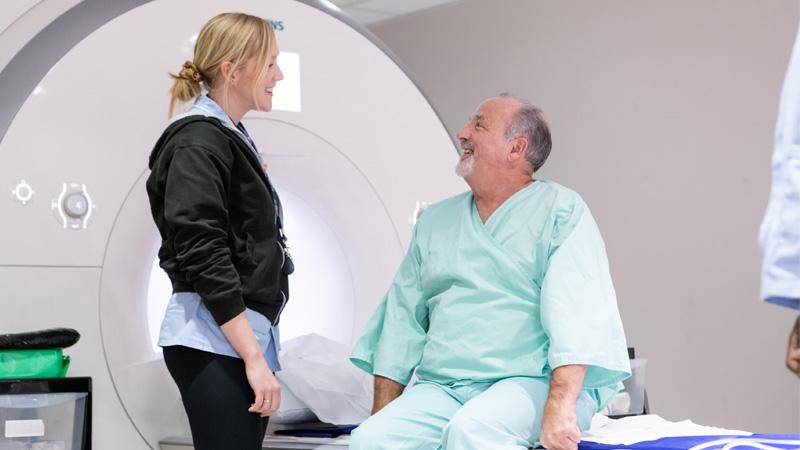Professor Louise Thomas, Professor of Metabolic Imaging at Westminster, worked closely with UK Biobank which has now scanned 100,000 volunteers for the world’s largest whole body imaging project. The record-breaking project will provide scientists with the most detailed look inside the human body yet to support the detection and diagnosis of disease.

UK Biobank has scanned the brains, hearts, abdomens, blood vessels, bones and joints of 100,000 volunteers over 10 years to reveal what is happening in people’s bodies as they age. The landmark study will help scientists to understand how, why and when people get sick and is already impacting how they detect and diagnose disease.
Since 2015, UK Biobank’s imaging data has been released in batches to scientists around the world who are using this data to develop better diagnostic tests for conditions such as heart disease, dementia and cancer. Soon, approved researchers will have access to over one billion de-identified images alongside UK Biobank’s existing information on lifestyle, medical history, genetics and blood proteins collected from the same volunteers over the past 15 years, which will allow them to see how all aspects of our lives influence our health in ways that were previously impossible.
Photo credit: Sherbert Lemon
Over 1,300 peer-reviewed scientific papers have been published based on the UK Biobank imaging data so far, which are already improving patient care. For example, NHS memory clinics across the UK now use processes developed from UK Biobank to analyse MR images, helping to more accurately diagnose dementia.
Imaging data on this scale not only provides more information on rare diseases and the different stages of common diseases but also allows scientists to compare healthy bodies to ones with multiple conditions, which will ultimately lead researchers to find more powerful markers of disease. This will allow for the prediction of disease years before symptoms begin.
The data is driving new diagnostic test and treatments, such as an AI model that develops a personalised version of a healthy heart than can be used to pinpoint difference between the patient’s real heart and its healthy model to catch potential signs of heart disease early.
The project has also led to a global democratisation of access to imaging data by turning the MR images into data that is useable by researchers outside the imaging field, including those in less wealthy countries. The data will be made available in staggered release and imaging from all 100,000 participants is expected to be made available to researchers by the end of 2025.
Professor Louise Thomas speaking about UK Biobank at the Royal Society
Professor Louise Thomas’ research in collaboration with Westminster’s Professor Jimmy Bell, Dr Brandon Whitcher and further colleagues from the University's Research Centre for Optimal Health (ReCOH) focuses on innovating Magnetic Resonance (MR) technology and developing cost-effective alternatives to MR Imaging (MRI). This pioneering work has fostered a close association with the UK Biobank imaging study and led to successful partnership with Calico LLC. Together they are developing deep learning-based methods for the automated analysis of MRI images, significantly accelerating biomedical research and clinical diagnostics.
Professor Thomas and Professor Bell have been involved with the UK Biobank imaging project from the start, translating the MRI body composition techniques into what is now the UK Biobank abdominal imaging protocol. They partnered with industry to validate both the MRI measurements and the data analysis, and what began as a relatively modest goal – to measure body fat, liver fat, and muscle – has evolved dramatically. Over the years, their team at the ReCOH has developed advanced analysis methods capable of labelling nearly every pixel in an image, allowing researchers to extract the maximum amount of information and value from each scan.
Following the project’s launch, Professor Thomas has made several media appearances to discuss the groundbreaking study. This includes interviews for Sky News and BBC World Service and quotes in articles by The Guardian and BBC News. Professor Thomas was also invited to speak at the Royal Society, the oldest national scientific society in the world and the leading national organisation for the promotion of scientific research in Britain, as part of the UK Biobank celebrations.
About the study Professor Thomas said: “UK Biobank’s imaging study has transformed the landscape of biomedical research forever. The sheer volume of data propelled major advances in computerised image analysis. Now researchers can measure the size, shape, and composition of nearly every organ and tissue in the body in seconds, rather than hours per person.”
The UK Biobank project directly contributes to the United Nations Sustainable Development Goal (SDGs) 3: Good Health and Well-being. Since 2019, the University of Westminster has used the SDGs holistically to frame strategic decisions to help students and colleagues fulfil their potential and contribute to a more sustainable, equitable and healthier society.
Find out more about studying Biological and Biomedical Sciences at the University of Westminster.
Updated 19 August 2025.









